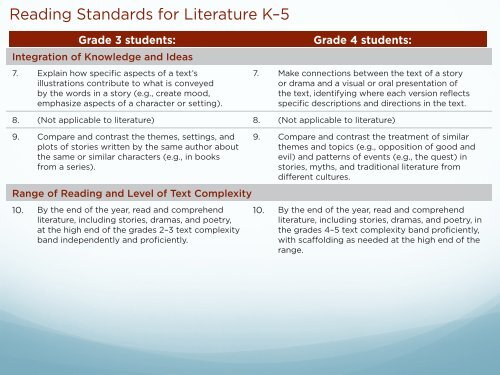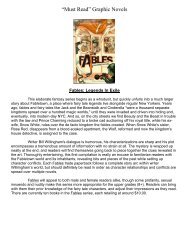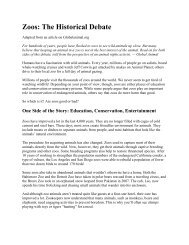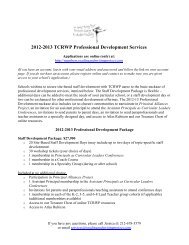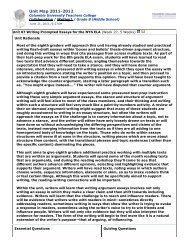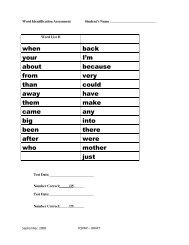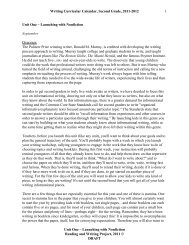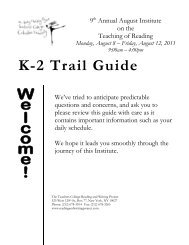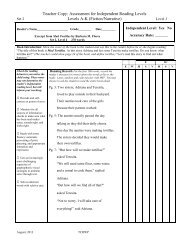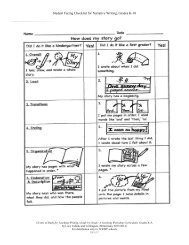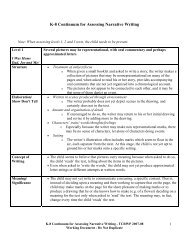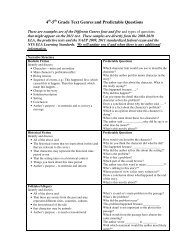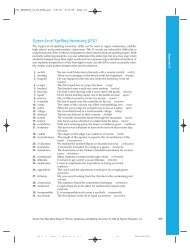Diary of a Reluctant Picky Reader - The Reading & Writing Project
Diary of a Reluctant Picky Reader - The Reading & Writing Project
Diary of a Reluctant Picky Reader - The Reading & Writing Project
Create successful ePaper yourself
Turn your PDF publications into a flip-book with our unique Google optimized e-Paper software.
<strong>Reading</strong> Standards for Literature K–56. Distinguish their own point <strong>of</strong> view from that <strong>of</strong>the narrator or those <strong>of</strong> the characters.Grade 3 students:Integration Key Ideas and <strong>of</strong> Knowledge Details and Ideas3. from Describe a series). characters in a story (e.g., their traits,motivations, or feelings) and explain how theiractions contribute to the sequence <strong>of</strong> events.10. By the end <strong>of</strong> the year, read and comprehendCraft literature, and Structure including stories, dramas, and poetry,4. at Determine the high end the meaning <strong>of</strong> the grades <strong>of</strong> words 2–3 and text phrases complexity asband they are independently used a text, and distinguishing pr<strong>of</strong>iciently. literal fromnonliteral language.writing or speaking about a text.6. Compare and contrast the point <strong>of</strong> view from whichdifferent stories are narrated, including the differencebetween first- and third-person narrations.Grade 4 students:7. 1. Explain Ask and how answer specific questions aspects to <strong>of</strong> demonstrate a text’s1. 7. Refer Make to connections details and between examples the in a text text <strong>of</strong> when a story 1. 7.illustrations understanding contribute <strong>of</strong> a text, to referring what is conveyed explicitly to theby text the as words the basis in a for story the (e.g., answers. create mood,explaining or drama and what a the visual text or says oral explicitly presentation and <strong>of</strong> whendrawing the text, inferences identifying from where the each text. version reflects2.8.emphasize aspects <strong>of</strong> a character or setting).Recount stories, including fables, folktales, and(Not myths applicable from diverse to literature) cultures; determine the2.8.specific descriptions and directions in the text.Determine a theme <strong>of</strong> a story, drama, or poemfrom (Not details applicable in the to text; literature) summarize the text.2.8.9.central message, lesson, or moral and explainCompare and contrast the themes, settings, and 9. Compare and contrast the treatment <strong>of</strong> similarhow it is conveyed through key details in the text.plots <strong>of</strong> stories written by the same author about themes and topics (e.g., opposition <strong>of</strong> good and9.the same or similar characters (e.g., in booksevil) and patterns <strong>of</strong> events (e.g., the quest) inRange <strong>of</strong> <strong>Reading</strong> and Level <strong>of</strong> Text Complexity3. Describe stories, myths, in depth and a character, traditional setting, literature or event fromin different a story or cultures. drama, drawing on specific detailsin the text (e.g., a character’s thoughts, words, oractions).10. By the end <strong>of</strong> the year, read and comprehendliterature, including stories, dramas, and poetry, in4. Determine the grades the 4–5 meaning text complexity <strong>of</strong> words band phrases pr<strong>of</strong>iciently,as with they scaffolding are used in as a needed text, including at the high those end <strong>of</strong> thethatrange.allude to significant characters found inmythology (e.g., Herculean).3.4.6.105. Refer to parts <strong>of</strong> stories, dramas, and poemswhen writing or speaking about a text, usingterms such as chapter, scene, and stanza;describe how each successive part builds onearlier sections.6. Distinguish their own point <strong>of</strong> view from that <strong>of</strong>the narrator or those <strong>of</strong> the characters.5. Explain major differences between poems,drama, and prose, and refer to the structuralelements <strong>of</strong> poems (e.g., verse, rhythm, meter)and drama (e.g., casts <strong>of</strong> characters, settings,descriptions, dialogue, stage directions) whenwriting or speaking about a text.6. Compare and contrast the point <strong>of</strong> view from whichdifferent stories are narrated, including the differencebetween first- and third-person narrations.5.6.


